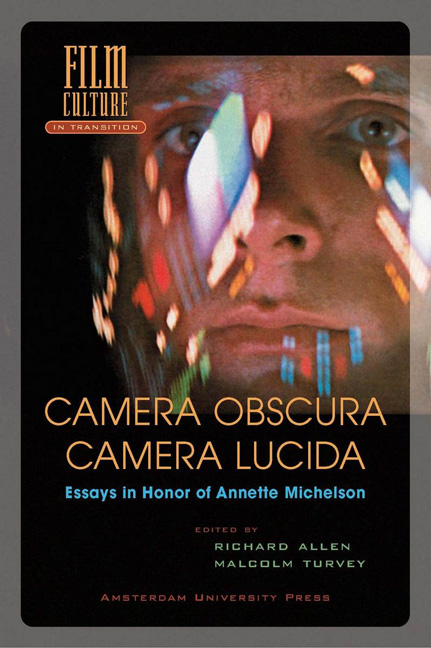Book contents
- Frontmatter
- Contents
- Acknowledgements
- Preface
- Introduction
- The Logic of an Illusion: Notes on the Genealogy of Intellectual Cinema
- Narcissistic Machines and Erotic Prostheses
- Loïe Fuller and the Art of Motion: Body, Light, Electricity and the Origins of Cinema
- Visitings of Awful Promise: The Cinema Seen from Etna
- Transfiguring the Urban Gray: László Moholy-Nagy’s Film Scenario ‘Dynamic of the Metropolis’
- Eisenstein’s Philosophy of Film
- Knight’s Moves
- Hitchcock and Narrative Suspense: Theory and Practice
- From the Air: A Genealogy of Antonioni’s Modernism
- Dr. Strangelove: or: the Apparatus of Nuclear Warfare
- Collection and Recollection: On Film Itineraries and Museum Walks
- Afterward: A Matter of Time: Analog Versus Digital, the Perennial Question of Shifting Technology and Its Implications for an Experimental Filmmaker’s Odyssey
- Select Bibliography
- List of Contributors
- Index
- Film Culture in Transition General Editor: Thomas Elsaesser
Transfiguring the Urban Gray: László Moholy-Nagy’s Film Scenario ‘Dynamic of the Metropolis’
Published online by Cambridge University Press: 25 January 2021
- Frontmatter
- Contents
- Acknowledgements
- Preface
- Introduction
- The Logic of an Illusion: Notes on the Genealogy of Intellectual Cinema
- Narcissistic Machines and Erotic Prostheses
- Loïe Fuller and the Art of Motion: Body, Light, Electricity and the Origins of Cinema
- Visitings of Awful Promise: The Cinema Seen from Etna
- Transfiguring the Urban Gray: László Moholy-Nagy’s Film Scenario ‘Dynamic of the Metropolis’
- Eisenstein’s Philosophy of Film
- Knight’s Moves
- Hitchcock and Narrative Suspense: Theory and Practice
- From the Air: A Genealogy of Antonioni’s Modernism
- Dr. Strangelove: or: the Apparatus of Nuclear Warfare
- Collection and Recollection: On Film Itineraries and Museum Walks
- Afterward: A Matter of Time: Analog Versus Digital, the Perennial Question of Shifting Technology and Its Implications for an Experimental Filmmaker’s Odyssey
- Select Bibliography
- List of Contributors
- Index
- Film Culture in Transition General Editor: Thomas Elsaesser
Summary
Few episodes in cinema history appear more secure than the genre of the city symphony that emerged in the 1920s and whose best-known examples remain BERLIN: SYMPHONY OF A GREAT CITY (Walther Ruttmann, 1927) and MAN WITH A MOVIE CAMERA (Dziga Vertov, 1929). Encompassing around twenty titles, city symphonies rely heavily upon montage to represent a cross-section of life in the modern metropolis. They typically are set in one or more identifiable metropoles whose population, central thoroughfares, and places of residence, employment, and leisure they depict over the course of a day, a temporal structure that has inflected films noir such as THE NAKED CITY (Jules Dassin, 1948) and countless examples of narrative and experimental cinema. Yet such works resist categorization as documentary, experimental, or narrative film. Their interest resides in the cinematographic preservation of ephemeral urban life no less than an aesthetic structure that itself evokes the rhythms, parallels, and contrasts of metropolitan civilization.
The project of explicating the city symphony – as well as the less chronologically structured city films of the 1920s in relation to the accounts of urban modernity developed by Georg Simmel, Walter Benjamin, and Siegfried Kracauer – is one to which film analysts over the past two decades have devoted increasing attention. It was Annette Michelson who introduced Simmel's work into cinema studies through her discussion of his 1903 essay ‘The Metropolis and Mental Life’ in a 1979 analysis of THE CRAZY RAY (PARIS QUI DORT) (René Clair, 1924). Reading Clair's film simultaneously as exploration of the ‘topography of a great city’ as well as metacinematic reflection upon the potentialities of the nascent film medium, Michelson stresses its representation of ‘temporality, apprehended as movement in space’ and the significance of the temporal organization of the workday as mainspring of the urban capitalist economy.
Yet despite the abundance of scholarship on the city films of the 1920s there remains a key text in its history that largely has been ignored: László Moholy Nagy's unfilmed scenario ‘Dynamic of the Metropolis’ (DM). Although known to cinema scholars through his films THE OLD PORT OF MARSEILLES (1929), LIGHT DISPLAY: BLACK, WHITE, GRAY (1930), AND BERLIN STILL LIFE (1931), Moholy-Nagy was a polymath whose virtuosity in the media of painting, photography, design, and pedagogical innovations at the Bauhaus have tended to overshadow his interest in cinema.
- Type
- Chapter
- Information
- Camera Obscura, Camera LucidaEssays in Honor of Annette Michelson, pp. 109 - 126Publisher: Amsterdam University PressPrint publication year: 2003



